Themed collection Recent Open Access Articles

Emerging investigator series: are we undervaluing septage? Rethinking septage management for nutrient recovery and environmental protection
Septage is an untapped waste stream that could be utilized for recovery of beneficial nutrients, energy, and water.

Environ. Sci.: Water Res. Technol., 2025,11, 1621-1628
https://doi.org/10.1039/D4EW00998C
A case study of ethical bridges: wastewater-based epidemiology in the Rubbertown Air Toxics and Health Assessment (RATHA) project
This case study underscores both the need for and the feasibility of ethical planning in environmental health research, particularly when using wastewater-based epidemiology in vulnerable communities.

Environ. Sci.: Water Res. Technol., 2025,11, 1363-1368
https://doi.org/10.1039/D5EW00234F
Lithium recovery from U.S. oil and gas produced waters: resource quality and siting considerations
Aqueous geochemistry, access to end-users, and workforce availability are important to assess lithium extraction potential from produced brines.

Environ. Sci.: Water Res. Technol., 2025,11, 536-541
https://doi.org/10.1039/D4EW00422A
Moving beyond silver in point-of-use drinking water pathogen control
Managing drinking water-associated pathogens that can cause infections in immunocompromised individuals is a persistent challenge, particularly for healthcare facilities where occupant exposures carry a substantial health risk.

Environ. Sci.: Water Res. Technol., 2024,10, 1009-1018
https://doi.org/10.1039/D3EW00564J
Wastewater research and surveillance: an ethical exploration
This article provides an ethical exploration of wastewater research surveillance, incorporating insights from data ethics, public health ethics, research ethics, and environmental and water ethics.

Environ. Sci.: Water Res. Technol., 2022,8, 2431-2438
https://doi.org/10.1039/D2EW00127F
Targeting current and future threats: recent methodological trends in environmental antimicrobial resistance research and their relationships to risk assessment
Recent research on antimicrobial resistance in the environment has emphasized targeted methods. Increased use of non-targeted methods is needed to determine how frequently novel resistance genes arise.
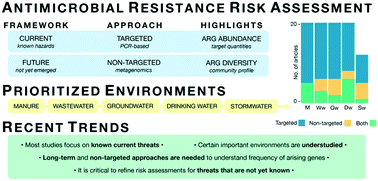
Environ. Sci.: Water Res. Technol., 2022,8, 1787-1802
https://doi.org/10.1039/D2EW00087C
Plant-wide systems microbiology for the wastewater industry
Infiltrating systems microbiology concepts in the water industry requires the development of a language of love and shared endpoints in analytical bioscience and process engineering at the (waste)water line.
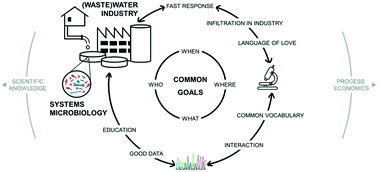
Environ. Sci.: Water Res. Technol., 2021,7, 1687-1706
https://doi.org/10.1039/D1EW00231G
Urban stormwater capture for water supply: look out for persistent, mobile and toxic substances
Urban stormwater is a source of persistent, mobile and toxic substances, however the risk for water resources is unknown.

Environ. Sci.: Water Res. Technol., 2023,9, 3094-3102
https://doi.org/10.1039/D3EW00160A
Emerging investigator series: the role of phage lifestyle in wastewater microbial community structures and functions: insights into diverse microbial environments
Harnessing phage for biological treatment is of growing interest, but an improved understanding of phage diversity, host range, lifestyle, molecular signaling, and genetic potential are needed for microbial community control.

Environ. Sci.: Water Res. Technol., 2023,9, 1982-1991
https://doi.org/10.1039/D2EW00755J
The potential contribution of urine source separation to the SDG agenda – a review of the progress so far and future development options
Closing the human nutrient cycle with decentralized urine separation would help to achieve progress in food security and water protection – especially in poor countries. For this, radical innovation is needed along the whole sanitation value chain.
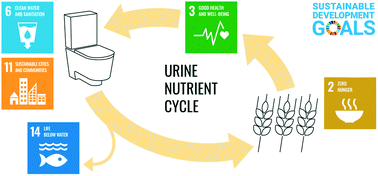
Environ. Sci.: Water Res. Technol., 2021,7, 1161-1176
https://doi.org/10.1039/D0EW01064B
Review of quantitative microbial risk assessments for potable water reuse
This review identified 30 studies from 1992–2024 that performed quantitative microbial risk assessments on potable reuse and compared individual assumptions, summarized influential parameters, and analyzed results.

Environ. Sci.: Water Res. Technol., 2025,11, 542-559
https://doi.org/10.1039/D4EW00661E
Mechanism of lithium ion selectivity through membranes: a brief review
The ion transportation process through a membrane was divided into 3 sequential stages, where the ion selectivity could be determined by the ion charge, hydration energy, channel size and surface chemistry.

Environ. Sci.: Water Res. Technol., 2024,10, 1305-1318
https://doi.org/10.1039/D3EW00769C
Quantitative sustainable design (QSD) for the prioritization of research, development, and deployment of technologies: a tutorial and review
This tutorial review synthesizes literature on sustainability analyses to introduce quantitative sustainable design (QSD) for technology research, development, and deployment.
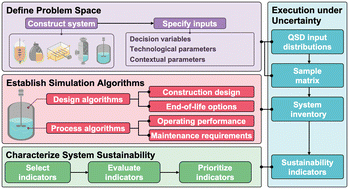
Environ. Sci.: Water Res. Technol., 2022,8, 2439-2465
https://doi.org/10.1039/D2EW00431C
Revisiting simultaneous sulfate reduction and ammonium oxidation in wastewater treatment – from inexplicable experimental observations to extended mechanistic hypotheses
Revisiting simultaneous sulfate reduction and ammonium oxidation phenomenon: from inexplicable experimental results to extended mechanistic hypothesis.

Environ. Sci.: Water Res. Technol., 2025,11, 1847-1860
https://doi.org/10.1039/D5EW00283D
Assessing the environmental impact of freshwater use in LCA: established practices and current methods
Extensive water use leads to scarcity, adversely affecting human health, ecosystems, and resources. Life cycle assessment (LCA) evaluates these impacts via damage pathways, using characterization models to quantify effects.

Environ. Sci.: Water Res. Technol., 2025,11, 196-221
https://doi.org/10.1039/D4EW00641K
Next generation decentralized water systems: a water-energy-infrastructure-human nexus (WEIHN) approach
This review highlights the pressing need for sustainable water management strategies within the water-energy-infrastructure-human nexus, and accentuates the critical roles of infrastructure and human engagement for sustainable water management.
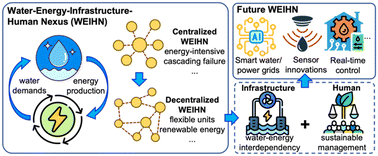
Environ. Sci.: Water Res. Technol., 2023,9, 2446-2471
https://doi.org/10.1039/D3EW00506B
Antibiotic resistance in urban stormwater: a review of the dissemination of resistance elements, their impact, and management opportunities
Traditional stormwater infrastructure facilitates the transport of antibiotic resistance genes while green stormwater infrastructure may capture the genes and promote horizontal gene transfer.

Environ. Sci.: Water Res. Technol., 2023,9, 2188-2212
https://doi.org/10.1039/D3EW00356F
Removal of metals from water using MOF-based composite adsorbents
This review article focuses on metal–organic framework (MOF) composites and the impact of mixing MOFs with other materials, such as polymers, carbon-based materials, and magnetic particles, to increase their performance to remove metals from water.

Environ. Sci.: Water Res. Technol., 2023,9, 1305-1330
https://doi.org/10.1039/D2EW00941B
Resource recovery technologies as microbial risk barriers: towards safe use of excreta in agriculture based on hazard analysis and critical control point
Individual resource recovery processes are monitored as health risk barriers.
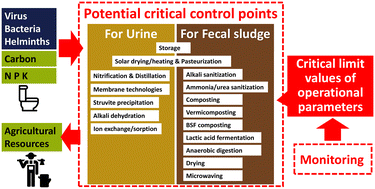
Environ. Sci.: Water Res. Technol., 2023,9, 1008-1029
https://doi.org/10.1039/D2EW00832G
Addressing main challenges in the tertiary treatment of urban wastewater: are homogeneous photodriven AOPs the answer?
Homogeneous photodriven advanced oxidation processes (HP-AOPs) have been increasingly investigated in past years as a possible alternative solution to conventional tertiary treatment methods of urban wastewater.

Environ. Sci.: Water Res. Technol., 2022,8, 2145-2169
https://doi.org/10.1039/D2EW00146B
Macroscopic covalent organic framework architectures for water remediation
This article has critically reviewed the story of macroscopic developments of COFs for water remediation. The various macroscopic COFs for removing toxic organic and inorganic pollutants have been systematically surveyed.

Environ. Sci.: Water Res. Technol., 2021,7, 1895-1927
https://doi.org/10.1039/D1EW00408E
Different routes of bismuth mineral transformation during pertechnetate and perrhenate uptake for subsurface remediation
Removal of pertechnetate 99TcO4− and perrhenate ReO4− during mineral transformation of the non-toxic basic bismuth subnitrate for subsurface remediation.

Environ. Sci.: Water Res. Technol., 2024,10, 2646-2654
https://doi.org/10.1039/D4EW00496E
Two weeks after the 2023 Maui wildfires: drinking water experiences and needs
To understand community impacts and needs after the August 2023 Maui wildfires, we conducted a rapid survey-based field investigation two weeks after the incident.

Environ. Sci.: Water Res. Technol., 2024,10, 2341-2356
https://doi.org/10.1039/D4EW00216D
Arsenic removal from Peruvian drinking water using milk protein nanofibril–carbon filters: a field study
A field study was carried out in Peru to remove arsenic from water in arsenic-contaminated regions using milk protein nanofibril filters. Results show that this technology can bring back water to drinking standard in both urban and rural settings.
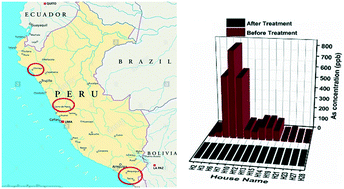
Environ. Sci.: Water Res. Technol., 2021,7, 2223-2230
https://doi.org/10.1039/D1EW00456E
Standardizing data reporting in the research community to enhance the utility of open data for SARS-CoV-2 wastewater surveillance
We propose a minimum set of meta-information to accompany the reporting of SARS-CoV-2 occurrence in wastewater for improved data interpretation.

Environ. Sci.: Water Res. Technol., 2021,7, 1545-1551
https://doi.org/10.1039/D1EW00235J
Well exposed: exploring the chemical and microbial composition in well and municipal drinking waters in Iowa
This study reveals twice the microbial diversity in well vs. municipal waters, highlighting the need for improved private well monitoring.

Environ. Sci.: Water Res. Technol., 2025,11, 2017-2034
https://doi.org/10.1039/D5EW00216H
Oxygen vacancy-engineered Bi2O2CO3 nanosheets for enhanced photodegradation of pharmaceuticals and personal care products in water
Defect engineering has emerged as a versatile approach for tailoring the properties of materials to meet specific functional applications and improve their properties.

Environ. Sci.: Water Res. Technol., 2025,11, 1951-1965
https://doi.org/10.1039/D5EW00367A
Novel coal fly ash–chitosan composite for highly efficient, cost-effective and stable removal of lead and chromium from industrial wastewater
In the present study, a novel and economical adsorbent was synthesized from a coal fly ash–chitosan composite to remove Pb2+ and Cr6+ from aqueous solutions.

Environ. Sci.: Water Res. Technol., 2025,11, 1977-2001
https://doi.org/10.1039/D5EW00257E
Elimination of miconazole nitrate from water by electro-Fenton: effect of operating parameters and degradation pathway
This study investigates the removal of miconazole, a widely used pharmaceutical, from water using the electro-Fenton process.

Environ. Sci.: Water Res. Technol., 2025,11, 1898-1908
https://doi.org/10.1039/D4EW00508B
Removal of psychopharmaceuticals from WWTP effluent by an algae–mussel trophic cascade: a potential nature-based solution?
Psychopharmaceuticals are an emerging group of hazardous contaminants that pose a risk to the aquatic environment.

Environ. Sci.: Water Res. Technol., 2025,11, 1643-1656
https://doi.org/10.1039/D5EW00011D
Insights into the degradation of carbamazepine using a continuous-flow non-thermal plasma: kinetics and comparison with UV-based systems
A continuous-flow DBD plasma reactor was used for carbamazepine degradation in an aqueous solution, with >90% degradation achieved under optimal conditions, surpassing UV-based AOPs in efficiency and energy cost.

Environ. Sci.: Water Res. Technol., 2025,11, 1568-1581
https://doi.org/10.1039/D4EW01042F
Nitrate enhances TCE removal by enriching bifunctional denitrifying/aerobic co-metabolizing microbes in the joint H2/O2 system
TCE removal by adjusting bi-functional microbes in the joint H2/O2 system.

Environ. Sci.: Water Res. Technol., 2025,11, 1505-1516
https://doi.org/10.1039/D5EW00046G
Novel fluidized-bed bioreactors with density-graded carriers for the bioremediation of nitrate in uranium industry effluents
Bioremediation of wastewater from the nuclear industry in a 3-phase aerobic airlift system and fluidized-bed anaerobic reactor with floating microbiological carriers.

Environ. Sci.: Water Res. Technol., 2025,11, 1339-1351
https://doi.org/10.1039/D5EW00077G
Comparing contaminants of emerging concern and microbial signatures of wastewater treated by membrane bioreactor and oxidation ditch methods
Despite effluent microbiome differences, contaminant of emerging concern signatures were consistent and similar in wastewater effluent treated by membrane bioreactor and oxidation ditch, indicating high-quality effluent from both treatment types.

Environ. Sci.: Water Res. Technol., 2025,11, 1296-1312
https://doi.org/10.1039/D4EW00793J
Enhancing fault detection in wastewater treatment plants: a multi-scale principal component analysis approach with the Kantorovich distance
Wavelet-based filtering combined with PCA effectively denoises data. The KD-driven method offers a reliable metric for detecting deviations from normal conditions without needing labelled data, making it suitable for anomaly detection.

Environ. Sci.: Water Res. Technol., 2025,11, 1215-1232
https://doi.org/10.1039/D4EW00831F
Energy-saving scheduling for multiple water intake pumping stations in water treatment plants based on personalized federated deep reinforcement learning
This study employs a data-driven personalized federated learning-based multi-agent attention deep reinforcement learning algorithm to address the intake scheduling problem of three water intake pumping stations in urban water treatment plants.

Environ. Sci.: Water Res. Technol., 2025,11, 1260-1270
https://doi.org/10.1039/D4EW00685B
Usability of waste plastic pyrolysis liquid/oil as a flotation collector in wastewater treatment
Marble processing industry wastewater contains a high amount of particulate solids. These wastewaters can be treated with high solid removal efficiency in flotation systems where pyrolysis oil is used as a collector.

Environ. Sci.: Water Res. Technol., 2025,11, 1233-1245
https://doi.org/10.1039/D5EW00027K
Energy recovery from organic matter in municipal wastewater using a two-stage system with high-rate contact stabilization and activated sludge processes under seasonal water temperature variations
A new technology using a high-rate contact stabilization process for wastewater treatment demonstrated superior energy recovery compared to an existing process, even while taking seasonal variations into account.

Environ. Sci.: Water Res. Technol., 2025,11, 1016-1025
https://doi.org/10.1039/D4EW00820K
Integrated assessment of the elimination of particle-associated fecal indicators in algal–bacterial granule photobioreactors
Two photo-sequencing batch reactors (PSBR) fed with real wastewater were evaluated to understand the elimination and particle association of fecal indicator bacteria (FIB) and coliphages.

Environ. Sci.: Water Res. Technol., 2025,11, 994-1006
https://doi.org/10.1039/D4EW00927D
Drying reduces the total PFAS concentration in biosolids and alters the PFAS profile
Drying biosolids in a full-scale dryer and lab-scale oven reduces measureable PFAS concentrations in biosolids.

Environ. Sci.: Water Res. Technol., 2025,11, 1007-1015
https://doi.org/10.1039/D4EW00890A
Disparities in potential nitrate exposures within Iowa public water systems
Disparities exist for marginalized populations (i.e., low-income populations) when it comes to potential exposure to elevated nitrate in drinking water.

Environ. Sci.: Water Res. Technol., 2025,11, 959-971
https://doi.org/10.1039/D4EW00907J
Effect of inoculum percentage and hydrogen supply on hydrogenotrophic denitrification driven by anaerobic granular sludge
Hydrogenotrophic denitrification driven by granular sludge is an eco-friendly alternative to conventional separation-based techniques, which ensure process stability, high NO3− removal efficiency and minimal greenhouse gas emissions.

Environ. Sci.: Water Res. Technol., 2025,11, 768-780
https://doi.org/10.1039/D4EW00776J
Bioremediation of uranium contaminated sites through the formation of U(VI) phosphate (bio)minerals
Removal of U(VI) in oxic groundwaters through the formation of low solubility U(VI) phosphate (bio)minerals, expanding the treatment envelope for in situ biomineralisation technologies.

Environ. Sci.: Water Res. Technol., 2025,11, 725-736
https://doi.org/10.1039/D4EW00846D
Behaviour of particle mobilization and reattachment under flushing conditions in PVC pipes using a full-scale laboratory system
Excessive accumulation of particulate material and biofilms on the inner walls of drinking water pipes increases the risk of water discoloration events, known to be the major cause of customer complaints worldwide.

Environ. Sci.: Water Res. Technol., 2025,11, 714-724
https://doi.org/10.1039/D4EW00764F
Effective measuring campaigns for reliable and informative full-scale WWTP data
More measurements do not mean more information in WWTPs. A structured experimental design procedure is crucial to plan measurement campaigns and measure the right things.

Environ. Sci.: Water Res. Technol., 2025,11, 667-680
https://doi.org/10.1039/D4EW00315B
Selective removal of Ca2+ from brackish water by electrodialysis desalination: process optimization and application
Based on the analysis of ion migration by electrochemical impedance spectroscopy, a guided electrodialysis integrated device was designed to desalinate brackish water and improve drinking water safety.

Environ. Sci.: Water Res. Technol., 2025,11, 655-666
https://doi.org/10.1039/D4EW00885E
Effect of intracellular algal organic matter and nitrate on disinfection byproduct formation in chlorinated water after UV/H2O2 and UV/Cl2 advanced oxidation processes
The type of advanced oxidation process is less consequential than the background water quality for formation of regulated disinfection byproducts, with nitrate and bromide being of particular significance.

Environ. Sci.: Water Res. Technol., 2025,11, 494-507
https://doi.org/10.1039/D4EW00749B
A machine learning framework to predict PPCP removal through various wastewater and water reuse treatment trains
ML Framework for PPCPs fate in WWTPs.

Environ. Sci.: Water Res. Technol., 2025,11, 481-493
https://doi.org/10.1039/D4EW00892H
Pathogen and indicator trends in southern Nevada wastewater during and after the COVID-19 pandemic
Wastewater samples spanning three years were analyzed for human enteric pathogens and fecal indicators, highlighting seasonal, geographic, and pandemic-related variations of interest for water reuse, microbial risk assessment, and source tracking.

Environ. Sci.: Water Res. Technol., 2025,11, 262-280
https://doi.org/10.1039/D4EW00620H
Emerging investigator series: Inactivation of antibiotic resistant bacteria and inhibition of horizontal resistance gene transfer is more effective by 222 than 254 nm UV
Disinfection of antibiotic-resistant B. subtilis, damage of its intracellular antibiotic resistance gene (ARG), and prevention of horizontal ARG transfer were greater by 222 than 254 nm, despite similar extracted ARG damage between UV wavelengths.

Environ. Sci.: Water Res. Technol., 2025,11, 306-316
https://doi.org/10.1039/D4EW00530A
A logic-based resilience metric for water resource recovery facilities
A new notion of resilience using signal temporal logic from computer science.

Environ. Sci.: Water Res. Technol., 2025,11, 377-392
https://doi.org/10.1039/D4EW00649F
Heavy metal leaching from stormwater control measures – insights into field and lab prestressed media and road-deposited sediments
Heavy metals bound to filter media from stormwater control measures can leach out under unfavorable conditions. The potential overestimation due to different prestressing (lab vs. field) was evaluated with respect to the potential mobile fraction.

Environ. Sci.: Water Res. Technol., 2025,11, 328-340
https://doi.org/10.1039/D4EW00388H
Equity-centered adaptive sampling in sub-sewershed wastewater surveillance using census data
Sub-city, or sub-sewershed, wastewater monitoring for infectious diseases offers a data-driven strategy to inform local public health response and complements city-wide data from centralized wastewater treatment plants.

Environ. Sci.: Water Res. Technol., 2025,11, 136-151
https://doi.org/10.1039/D4EW00552J
Respiratory human adenovirus outbreak captured in wastewater surveillance
Respiratory adenovirus wastewater surveillance was compared to clinical data from a 2022 outbreak, showing a correlation with cases. Respiratory adenoviruses were less prevalent, with types 40/41 dominating. The schematic illustrates findings.

Environ. Sci.: Water Res. Technol., 2025,11, 126-135
https://doi.org/10.1039/D4EW00521J
Detection of Omicron variant in November 2021: a retrospective analysis through wastewater in Halifax, Canada
This study evaluates the efficacy of wastewater surveillance and passive sampling techniques for the early detection of the SARS-CoV-2 Omicron variant in a university setting in Halifax, Canada.

Environ. Sci.: Water Res. Technol., 2025,11, 100-113
https://doi.org/10.1039/D4EW00350K
Willingness to pay for nationwide wastewater surveillance system for infectious diseases in Japan
A nationally-representative survey indicated that the population's valuation would economically justify the nationwide wastewater surveillance system in Japan.

Environ. Sci.: Water Res. Technol., 2025,11, 29-38
https://doi.org/10.1039/D4EW00332B
Solid–liquid partitioning of dengue, West Nile, Zika, hepatitis A, influenza A, and SARS-CoV-2 viruses in wastewater from across the USA
Limited information is available on the fate of respiratory and arthropod-borne viruses in wastewater.

Environ. Sci.: Water Res. Technol., 2025,11, 88-99
https://doi.org/10.1039/D4EW00225C
Improved microbial water quality and ozone performance following coagulation: implications for carbon based advanced treatment for potable reuse
Coagulation/flocculation of secondary effluent with FeCl3 (1) removed MS2 bacteriophage and bacterial endospores up to 2–3 LRVs, (2) removed rapid surrogates at levels correlative with microbial removal, and (3) improved downstream O3 performance.

Environ. Sci.: Water Res. Technol., 2024,10, 3158-3171
https://doi.org/10.1039/D4EW00638K
Sorption and biodegradation of stormwater trace organic contaminants via composite alginate bead geomedia with encapsulated microorganisms
We quantified sorption of stormwater relevant trace organic contaminants and dissolved phosphorus to a novel composite-alginate geomedia. We demonstrated coupled sorption and biodegradation of a representative tirewear compound via the geomedia.

Environ. Sci.: Water Res. Technol., 2024,10, 3339-3357
https://doi.org/10.1039/D4EW00600C
Environmental and private property contamination following the Norfolk Southern chemical spill and chemical fires in Ohio
In February 2023, a train derailment in Ohio caused a chemical spill and fires releasing contaminants into the air, soil, waterways, and buildings.

Environ. Sci.: Water Res. Technol., 2024,10, 3007-3023
https://doi.org/10.1039/D4EW00456F
Effect of extracellular organic matter (EOM) accumulation on algal proliferation and disinfection by-product precursors during cyclic cultivation
Algal blooms, driven by nutrient enrichment from nitrogen and phosphorus, pose significant challenges to water treatment processes, particularly due to the accumulation of extracellular organic matter (EOM).

Environ. Sci.: Water Res. Technol., 2024,10, 3024-3034
https://doi.org/10.1039/D4EW00207E
Phosphorus release from sewage sludge and digestate driven by biological sulfate reduction: effect of feed sulfate concentration and thermal hydrolysis
Recovering phosphorus from sewage sludge is a strategic, circular approach to ensure long-term phosphorus availability for future generations, supporting sustainability and resource preservation.

Environ. Sci.: Water Res. Technol., 2024,10, 2897-2905
https://doi.org/10.1039/D4EW00322E
A comprehensive study on the physicochemical characteristics of faecal sludge from septic tank and single pit latrine facilities in a typical semi-urban Indian town: a case study of Rajasthan, India
Faecal sludge (FS) samples were analysed to assess their characteristics. FS has high chemical oxygen demand, ranging from 4406 to 160 000 mg l−1, influenced by sludge age, sanitation type, and inflow/outflow to onsite sanitation contaminants.

Environ. Sci.: Water Res. Technol., 2024,10, 2906-2928
https://doi.org/10.1039/D4EW00127C
Lead ion (Pb2+) electrochemical sensors based on novel Schiff base ligands
The work reports the development of an AuNPs-L1/SPCE sensor based on a novel L1 Schiff base, with enhanced Pb2+ sensitivity and LOD of 0.298 μM. The sensor is suitable for Pb2+ detection in seawater with no sample treatment.

Environ. Sci.: Water Res. Technol., 2024,10, 2997-3006
https://doi.org/10.1039/D4EW00485J
Carbon flows and biochar stability during co-pyrolysis of human faeces with wood biomass
The systematic quantification of carbon flows and biochar stability when co-pyrolysing human faeces with wood biomass at different blending ratios and temperatures.

Environ. Sci.: Water Res. Technol., 2024,10, 2709-2722
https://doi.org/10.1039/D4EW00513A
Membrane technology for water reuse in decentralised non-sewered sanitation systems: comparison of pressure driven (reverse osmosis) and thermally driven processes (membrane distillation and pervaporation)
Thermally driven membrane processes provide an alternative method to conventional pressure driven processes to recover high quality water and manage odour from concentrated blackwater, using a low-grade heat source instead of electrical energy.

Environ. Sci.: Water Res. Technol., 2024,10, 2831-2843
https://doi.org/10.1039/D4EW00200H
UV-LED irradiation for biofouling reduction in drip irrigation emitters fed with wastewater effluent
To improve efficiency of drip irrigation emitters fed by treated wastewater, it is desired to minimize biofouling clogging. In the present study efficiency of UV-LED and chlorine to reduce biofilm formation was compared.

Environ. Sci.: Water Res. Technol., 2024,10, 2723-2735
https://doi.org/10.1039/D4EW00271G
Does the number of cells of individual strains correlate with their contribution to the total substrate turnover within a microbial community?
In a synthetic binary culture, cell numbers derived by qPCR did not reflect the contribution of individual strains to the total substrate turnover.

Environ. Sci.: Water Res. Technol., 2024,10, 2466-2477
https://doi.org/10.1039/D4EW00511B
Innovations in water desalination: enhancing air gap membrane distillation performance by the incorporation of clay nanoparticles into PVDF matrix membranes
Adding clay nanoparticles into PVDF MMMs enhances MD performance. Higher OMT loadings improve contact angle, LEP, and flux. Long-term operation shows no flux reduction. Humic acid foulant reduces clay membrane flux by 45% vs. 60% for commercial PVDF.

Environ. Sci.: Water Res. Technol., 2024,10, 2418-2431
https://doi.org/10.1039/D4EW00326H
Measuring heat transfer processes in gully pots for real-time estimation of accumulated sediment depths
The accumulation of sediments in stormwater systems negatively affects their functioning.

Environ. Sci.: Water Res. Technol., 2024,10, 2392-2405
https://doi.org/10.1039/D4EW00389F
About this collection
Please see below for recent Open Access papers published in Environmental Science: Water Research & Technology.